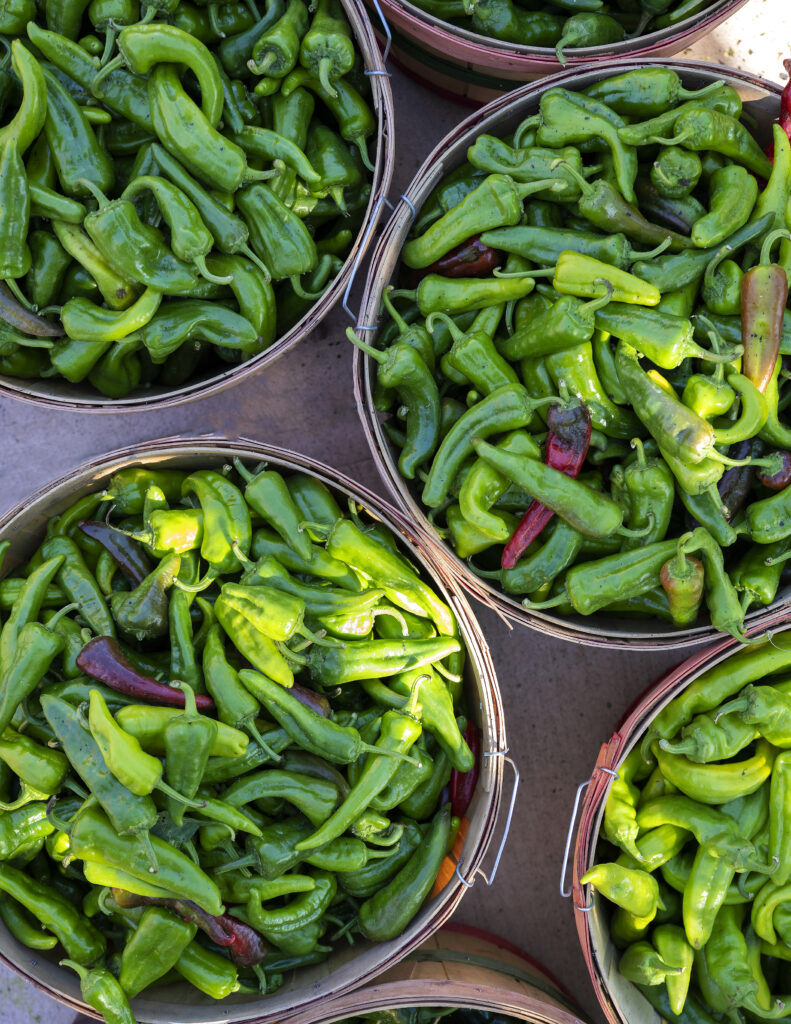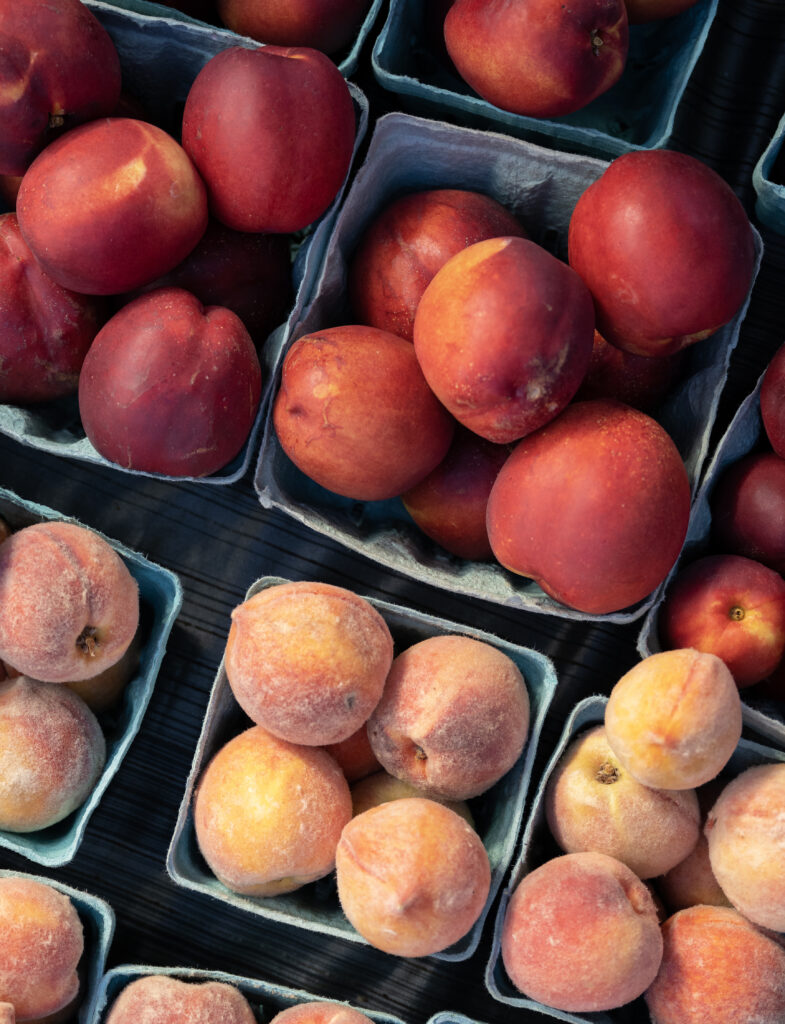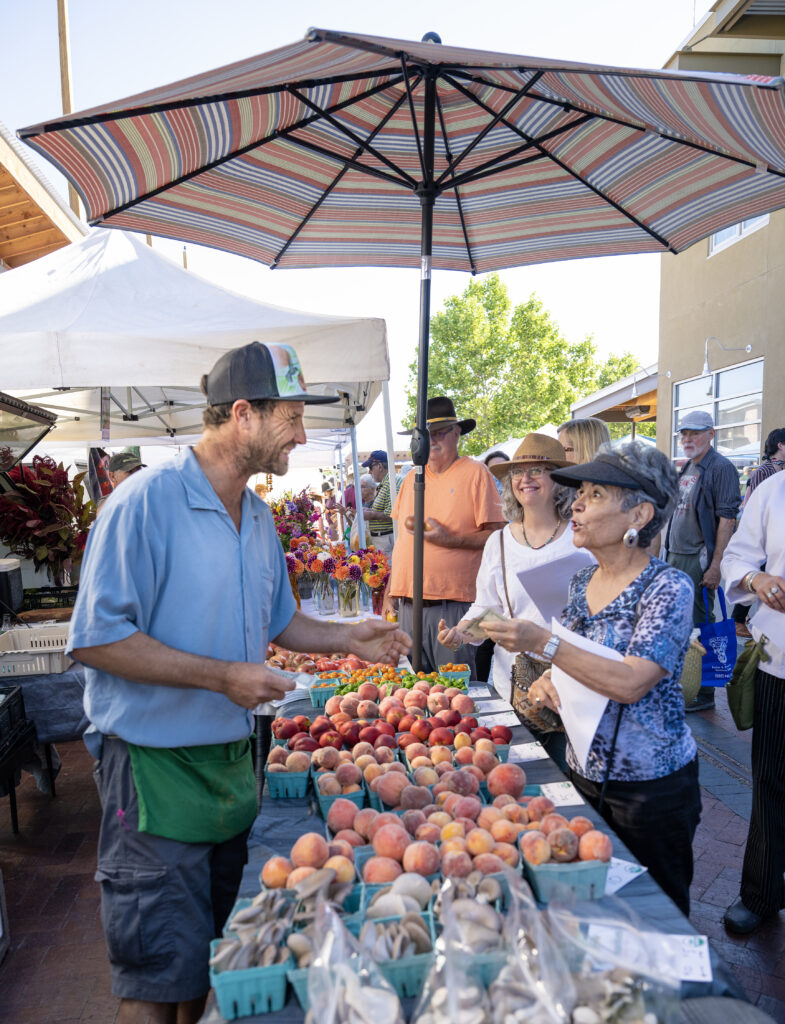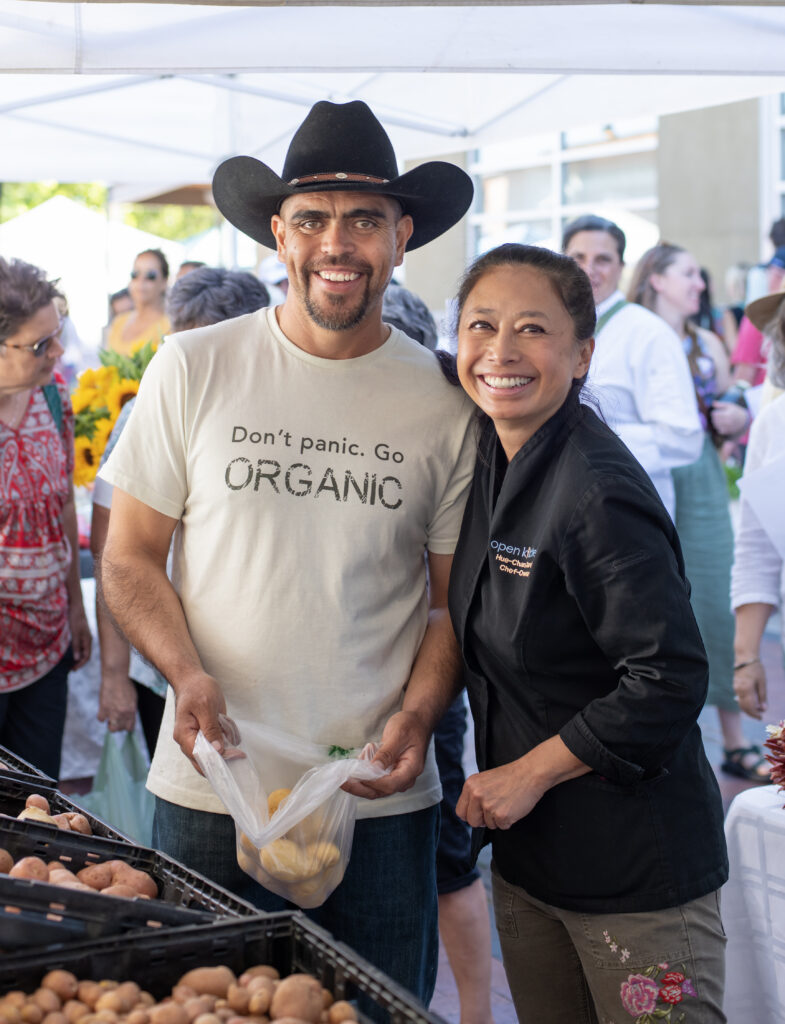On a Saturday morning in mid-August, the Santa Fe Farmers’ Market is resplendent with produce. A good monsoon season has blessed local farmers, with a relief after a bone-dry spring. It is not even 8 o’clock and already market patrons are lined up for tomatoes, corn, chiles, peppers of every color of the rainbow; cucumbers, garlic, onions, and greens, chives and squash, an array of potatoes in multiple colors and sizes. At photographer Doug Merriam’s booth inside the building, seven people gather to listen to a brief introduction delivered by Hue-Chan Karels, owner of Open Kitchen, and Merriam, whose book Farm Fresh Journey: Santa Fe Farmer’s Market Cookbook is for sale at his booth and also provides the recipes for the day’s cooking adventure with Open Kitchen: Santa Fe Farmers’ Market Tour and Cooking Class.

A Class at the Farmers’ Market
The recipes in the book, and that the class participants will make today came from the farmers, Merriam says, sometimes scribbled on a scrap of paper also with no quantities or measures. “I made each recipe several times, to test and make consistent the quantities and weights,” he says. Merriam, a long-time travel and lifestyle photographer, is a self-professed foodie, finding his element at the intersection of the two in the highly photographable market.
When it’s time to shop, Merriam grabs his cameras, while Hue-Chan and Open Kitchen chefs Leslie Chavez (who has since moved on to another kitchen) and Erica Tai shepherd the group from booth to booth, shopping for ingredients for the four recipes they’ll make today. The first stop involves purchasing corn from Shwebach Farm in Moriarty, a farming community on the plains southeast of Santa Fe. The group is given a quick corn fun-facts quiz from Dean Schwebach, also adorned appropriately in a corn hat (picture a Wisconsin cheese hat, only a corn cob). Did you know that corn is 20,000 years old, and is a cultivated non-native grass that air-pollinates? Meanwhile, the chefs choose the larger, less sweet variety for the two uses in the recipe — corn stew and the filling for the poblanos.

Exploring the Farms and Making Connections
Next up, a visit to Jose Gonzalez, from Lyden where he farms 10 acequia-irrigated acres on the west side of the Rio Grande. He grows squash, cucumbers, corn, potatoes, beans, sunflowers, and the signature peppers his wife Maria uses in her ristras and decorations. Gonzalez then helps the participants pick out medium-sized yellow potatoes from his bounty.
At the tent next door, students gather yellow and white peaches from Christopher and Taylor Bassett (Freshies), also in Lyden. Students purchase chives from Kristin Davenport and Avrum Katz of Yucca Bird Herb Farm in Llano in Taos County, and then cucumbers from Lisa Anderson and Malandra Farm in Abiquiu. Chef Leslie instructs the shoppers that the cucumbers don’t have to be perfect — they can use the “less pretty ones,” as they will be turning them into strips.

Romero Farm poblano chiles finish out the shopping excursion: “Peppers in the house!” Matt Romero shouts like a carnival barker, as he spins the roasting cage, the scent reminding New Mexicans of the approaching autumn.
The group then heads to Open Kitchen. Hue-Chan launched Open Kitchen in 2016 in Santa Fe, offering cooking classes, curated private dinners, and culinary escapades from Vietnam to the Santa Fe Farmers Market. Open Kitchen in Santa Fe was inspired by a meal at Café Pasqual, she says. “It was 2007, and it was shared joy and the experience of community. It is always about community around food, and Santa Fe has really embraced the concept.”
Cooking Together
Hue-Chan’s boundless energy keeps everyone on track as the cooking begins. Under the guidance of the chefs, the two groups study the recipes. The chefs impart nuggets of information, such as using the back of the knife to extract the sweet corn juice after removing the kernels from the cob. Chef Erica reminds them to save the cobs for vegetable stock or as a base for a velouté. They receive guidance on removing the seeds and pulp from peppers and a demonstration of rolling thin slices of cucumber around a goat cheese filling. Plus, blanching chives so they become pliable will play a role in Chef Erica’s plating artistry. The room fills with lively conversation, topics ranging from politics to food to raising chickens. Hue-Chan then turns on some jazz, visiting with the cooks and bustling back and forth to the kitchen.

When it’s time to eat, the detritus of three hours of chopping, slicing, de-seeding, and roasting, cleared away, and seven participants — five of whom have taken Open Kitchen classes before—gather to taste and compare the difference between the two groups. There is laughter and conversation over the table and the requisite group photo. They share phone numbers and make promises to reconnect again at the community table.
Story by Emily Esterson / Photography by Doug Merriam
Subscribe to TABLE Magazine‘s print edition.

